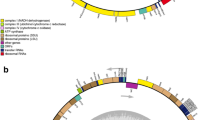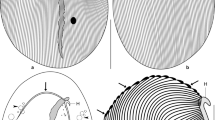Abstract
To date, molecular systematics of Myxogastria has been based primarily on small subunit ribosomal RNA (SSU rRNA) and elongation factor 1-alpha (EF-1α) genes. To establish a natural classification system for the organisms, we examined phylogenetic relationships among myxogastrian species using cytochrome c oxidase subunit I (COI) and SSU rRNA genes. Twenty new sequences were obtained, including 10 COI and 10 SSU rRNA sequences, were compared with sequences of related species from GenBank in order to construct phylogenic trees. The analysis of the two data sets supported the modern phylogeny of myxogastria: orders Liceida and Trichiida formed a sister group at the most basal clade, while orders Stemonitida and Physarida formed a close group, and order Echinostelida was a sister group to Stemonitida and Physarida. However, the partial COI sequences were too conserved to resolve of the branches in Stemonitida and Physarida. In addition, we also deemed the specific edited mRNA events of COI sequences in myxogastrian species.
Similar content being viewed by others
References
Stephenson, S.L., From morphological to molecular: studies of myxomycetes since the publication of the Martin and Alexopoulos (1969) monograph, Fungal Diversity, 2011, vol. 50, no. 1, pp. 21–34.
Alexopoulos, C.J., Blackwell, M., and Mims, C.W., Introductory Mycology, New York: Wiley, 1996, 4th ed.
Pawlowski, J. and Burki, F., Untangling the phylogeny of amoeboid protists, J. Eukaryotic Microbiol., 2009, vol. 56, no. 1, pp. 16–25.
Fiore-Donno, A.M., Nikolaev, S.I., Nelson, M., et al., Deep phylogeny and evolution of slime moulds (Mycetozoa), Protist, 2010, vol. 161, no. 1, pp. 55–70.
Martin, G.W. and Alexopoulos, C.J., The Myxomycetes, Iowa City: University of Iowa Press, 1969.
Ross, I.K., The Stemonitomycetidae, a new subclass of myxomycetes, Mycologia, 1973, vol. 65, no. 2, pp. 477–485.
Collins, O.N.R., Myxomycete biosystematics: some recent developments and future research opportunities, Bot. Rev., 1979, vol. 45, no. 2, pp. 145–201.
Fiore-Donno, A.M., Berney, C.D., Pawlowski, J., et al., Higher-order phylogeny of plasmodial slime molds (Myxogastria) based on elongation factor 1-A and small subunit rRNA gene sequences, J. Eukaryotic Microbiol., 2005, vol. 52, no. 3, pp. 201–210.
Shadwick, L.L., Spiegel, F.W., Shadwick, J.D.L., et al., Eumycetozoa = Amoebozoa?: SSUrDNA phylogeny of protosteloid slime molds and its significance for the amoebozoan supergroup, PLoS One, 2009, vol. 4, no. 8.
Cavalier-Smith, T., Early evolution of eukaryote feeding modes, cell structural diversity, and classification of the protozoan phyla Loukozoa, Sulcozoa, and Choanozoa, Eur. J. Protistol., 2013, vol. 49, no. 2, pp. 115–178.
Fiore-Donno, A.M., Clissmann, F., Meyer, M., et al., Two-gene phylogeny of bright-spored myxomycetes (slime moulds, superorder Lucisporidia), PLoS One, 2013, vol. 8, no. 5, e62586
Batishcheva, N., Kartavtsev, Y.P., and Bogutskaya, N., Phylogenetic analysis of Altai osmans of the genus Oreoleuciscus (Pisces, Cyprinidae, Leuciscinae), based on the analysis of the cytochrome oxidase 1 gene (Co-1) sequence, Russ. J. Genet., 2011, vol. 47, no. 10, pp. 1188–1197.
Kartavtsev, Y.P. and Lee, J.-S., Analysis of nucleotide diversity at the cytochrome b and cytochrome oxidase 1 genes at the population, species, and genus levels, Russ. J. Genet., 2006, vol. 42, no. 4, pp. 341–362.
Demin, A., Polukonova, N., and Mugue, N., Molecular phylogeny and the time of divergence of minges (Chironomidae, Nematocera, Diptera) inferred from a partial nucleotide sequence of the cytochrome oxidase I gene (COI), Russ. J. Genet., 2011, vol. 47, no. 10, pp. 1168–1180.
Hebert, PP. D., Ratnasingham, S. and de Waard, J.R., Barcoding animal life: cytochrome c oxidase subunit 1 divergences among closely related species, Proc. R. Soc. London, Ser. B, 2003, vol. 270, no. S1, pp. S96–S99.
Nassonova, E., Smirnov, A., Fahrni, J., et al., Barcoding amoebae: comparison of SSU, ITS and COI genes as tools for molecular identification of naked lobose amoebae, Protist, 2010, vol. 161, no. 1, pp. 102–115.
Kamono, A., Meyer, M., Cavalier-Smith, T., et al., Exploring slime mould diversity in high-altitude forests and grasslands by environmental RNA analysis, FEMS Microbiol. Ecol., 2012, vol. 84, no. 1, pp. 98–109.
Stamatakis, A., RAxML-VI-HPC: maximum likelihood-based phylogenetic analyses with thousands of taxa and mixed models, Bioinformatics, 2006, vol. 22, no. 21, pp. 2688–2690.
Ronquist, F. and Huelsenbeck, J. PP., MrBayes 3: Bayesian phylogenetic inference under mixed models, Bioinformatics, 2003, vol. 19, no. 12, pp. 1572–1574.
Bogdanov, A., Stakheev, V., Zykov, A., et al., Genetic variation and differentiation of wood mice from the genus Sylvaemus inferred from sequencing of the cytochrome oxidase subunit 1 gene fragment, Russ. J. Genet., 2012, vol. 48, no. 2, pp. 186–198.
Lopatkin, A., Khrisanfova, G., Voronin, M., et al., Polymorphism of the cox1 gene in bird schistosome cercaria isolates (Trematoda, Schistosomatidae) from ponds of Moscow and Moscow oblast, Russ. J. Genet., 2010, vol. 46, no. 7, pp. 873–880.
Horton, T.L. and Landweber, L.F., Evolution of four types of RNA editing in myxomycetes, RNA, 2000, vol. 6, no. 10, pp. 1339–1346.
Gott, J., Visomirski, L., and Hunter, J., Substitutional and insertional RNA editing of the cytochrome c oxidase subunit 1 mRNA of Physarum polycephalum, J. Biol. Chem., 1993, vol. 268, no. 34, pp. 25483–25486.
Pankratova, E.V. and Stepchenko, A.G., RNA editing in eukaryotic genome expression, Russ. J. Genet., 2010, vol. 46, no. 1, pp. 1–8.
Gott, J.M., Parimi, N., and Bundschuh, R., Discovery of new genes and deletion editing in Physarum mitochondria enabled by a novel algorithm for finding edited mRNA, Nucleic Acids Res., 2005, vol. 33, no. 16, pp. 5063–5072.
Krishnan, U., Barsamian, A., and Miller, D.L., Evolution of RNA editing sites in the mitochondrial small subunit rRNA of the Myxomycota, Methods Enzymol., 2007, vol. 424, no. 4, pp. 197–220.
El-Hage, N., Little, C., Clark, J.D., et al., Biosystematics of the Didymium squamulosum complex, Mycologia, 2000, vol. 92, no. 1, pp. 54–64.
Clark, J. and Stephenson, S.L., Biosystematics of the myxomycetes Didymium squamulosum, Physarum compressum, and Physarum melleum: additional isolates, Mycotaxon, 2003, vol. 85, no. 1, pp. 85–89.
Winsett, K.E. and Stephenson, S.L., Using ITS sequences to assess intraspecific genetic relationships among geographically separated collections of the myxomycete Didymium squamulosum, Rev. Mex. Micol., 2008, vol. 27, no. 1, pp. 59–65.
Li, S., Wang, Q., and Li, Y., Molecular analysis of Didymium squamulosum based on ribosomal gene sequences, Mycosystema, 2013, vol. 32, no. 4, pp. 764–770.
Nannenga-Bremekamp, N., A Guide to Temperate Myxomycetes, Bristol: Biopress Bristol, 1991.
Farr, M.L., Some new myxomycetes records for the neotropics and some taxonomic problems in the Myxomycetes, Proc. Iowa Acad. Sci., 1974, vol. 81, no. 1, pp. 37–40.
Author information
Authors and Affiliations
Corresponding author
Additional information
The article is published in the original.
Rights and permissions
About this article
Cite this article
Liu, Q.S., Yan, S.Z. & Chen, S.L. Further resolving the phylogeny of Myxogastria (slime molds) based on COI and SSU rRNA genes. Russ J Genet 51, 39–45 (2015). https://doi.org/10.1134/S1022795414110076
Received:
Published:
Issue Date:
DOI: https://doi.org/10.1134/S1022795414110076




